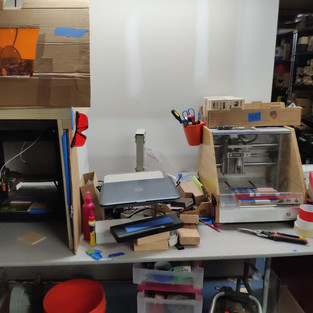Sharing activity with Exit 5A
- flamemachines
- Nov 16, 2018
- 4 min read
Updated: Nov 17, 2018
On Nov 11 evening, our team has a sharing activity with Exit 5A team. Exit 5A Robotics have completed its 4th year in FLL, very high-energetic and experienced team. We learn a lot from them.

The Exit 5A team did a project on the health of astronauts in microgravity. Being in space for long periods of time can create big health problems, such as double vision, but Exit 5A did their project on spinal stenosis, a predicament when astronauts’ intervertebral disks begin to swell. This causes bad health for astronauts. So the Exit 5A team decided to inject a liquid into astronauts using an intravenous line (IV). IV ejection is already available on earth, so they just have to apply the same procedures in space.
I liked their whole presentation in general, though they should have their visual ready later, it was hard to understand without one.

Their robot presentation was actually quite simple, though their attachments and robot are very complex and hard to understand.
I liked their extraction attachment. They used a pulling method. I am currently working on replacing Hendry’s current attachment into a pull out into box kind of attachment. It will have more room for error, and it will be more reliable. Also, it will save time by combining the two mini-runs into one run.
BY:Shining
Exit 5A team did a presentation on how long term stay in space can affect astronauts, and solutions. They discussed how the microgravity can affect the astronaut’s eyesights, spine, etc. The most interesting part was the eyesight part. I never knew that if your eyes are pressed on behind, then you get bad eyesight. I am glad that they acknowledged the eyesight problem because if the astronauts returned home and the space agencies weren’t aware of that problem, the astronauts will be crippled for life.
I learned that our robot is simple compared to Exit 5A’s robot.
Rubber bands are very useful
You can use gears in many different ways
Always have one person have the next attachment in hand, the other person will take the current one off, and put the stuff in.
By: Alex
On our special meet with the Exit 5A Robotics team, we saw their presentation for the FLL project. Their main topic was about how an astronaut’s eyeballs performance would decline over time in space. A special fluid in the body can build up, putting pressure on the nerves of the eye. The solution was to come up with a fluid-extraction medicine that will cut down on the fluid buildup.
In this project, I loved how the team went into so much detail on the solution. They thoroughly taught me their concept and how they could stop this problem. What I suggest for them to improve is that I believe they should make their slides intuitive and easy reading, so that I could understand that difficult terminology that they were using.
By: Hendry
The Exit 5A team had a presentation which was about fixing eye problems and pressure in the brain from gravity. Because there is no gravity in space, more fluids go up to the brain, increasing brain pressure and putting pressure on the eyes, making eyesight worse, the longer astronauts stay. The team had chosen to use an intravenous line (IV.) Since it is already being used here on earth, they had to figure out a way to inject it in space. There is already a mechanism for that, which they will use to inject this liquid. What I found interesting was how they were going to install it, because they were going to use a solution that was already being used for the same problem, just in space. Also, the team was going to use an injector already being used in space. I found this interesting because I feel that the easiest way for solutions is to make one up, like my team and I did. I did like this presentation as a whole, but I have a few suggestions. One is to simplify the vocabulary, speak louder, and to speak clearly. Sometimes I couldn’t make out the words, and I got confused. They also needed to simplify some vocabulary, because they were in high school, and I and the others on my team are 5th and 6th graders. A visual would also have helped with keeping me from getting confused because it helps to explain some things on its own. Their visuals were work in progress, but after we saw them, we understood a bit more.
Their presentation for their robot game was quite simple, but when I saw the robot with its attachments, I was utterly perplexed. Their attachments were much more complicated than ours.
There were many things I learned from their presentation for the robot game and their attachments, which include the following.
Using rubber bands can make many passive attachments.
Bigger wheels don’t need as much weight to complete Escape Velocity and Crater Crossing.
They weren’t shooting for the best in all missions; Aerobic Exercise takes long so they only did it up to the gray and not the orange.
By: Emily















Comments